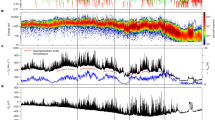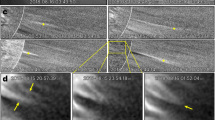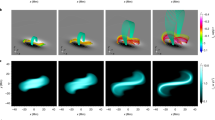Abstract
Magnetic fields play a crucial role in heating the outer atmospheres of the Sun and Sun-like stars, but the mechanisms by which magnetic energy in the photosphere is converted to thermal energy in the corona remain unclear. Observations show that magnetic fields emerge onto the solar surface as bipolar regions with a broad range of length scales. On large scales, the bipolar regions survive for months before dispersing diffusively1,2,3. On the smaller scales, individual bipolar regions disappear within days but are continuously replenished by new small flux concentrations, resulting in a sustained state of mixed polarity4. Here we determine the rate of emergence of these small bipolar regions and we argue that the frequent magnetic reconnections associated with these regions (an unavoidable consequence of continued flux replacement) will heat the solar atmosphere. The model that describes the details of these mixed-polarity regions4 is complementary to the traditional diffusion model for large-scale flux dispersal1,2,3 and a combination of the two should lead to a more complete understanding of the role of magnetic fields in stellar atmospheres.
This is a preview of subscription content, access via your institution
Access options
Subscribe to this journal
Receive 51 print issues and online access
$199.00 per year
only $3.90 per issue
Buy this article
- Purchase on Springer Link
- Instant access to full article PDF
Prices may be subject to local taxes which are calculated during checkout

Similar content being viewed by others
References
Leighton, R. B. Transport of magnetic fields on the sun. Astrophys. J. 140, 1547–1562 (1964).
DeVore, C. R., Sheeley, N. R. J, Boris, J. P., Young, T. R. & Harvey, K. L. Numerical simulations of large-scale solar magnetic fields. Austr. J. Phys. 38, 999–1007 (1985).
Wang, Y.-M., Nash, A. G. & Sheeley, N. R. J Magnetic flux transport on the sun. Science 245, 712–718 (1989).
Schrijver, C. J., Title, A. M., van Ballegooijen, A. A., Hagenaar, H. J. & Shine, R. A. Sustaining the quiet chromospheric network: a dynamic balance of flux emergence, fragmentation, merging, and cancellation. Astrophys. J. 487, 424–437 (1997).
Spruit, H. C., Nordlund, & & Aring; & Title, A. M. Solar convection. Annu. Rev. Astron. Astrophys. 28, 263–301 (1990).
Scherrer, P. H. et al. The solar oscillations investigation—michelson doppler imager. Solar Phys. 162, 129–188 (1995).
Schrijver, C. J. et al. Dynamics of the chromospheric network: mobility, dispersal, and diffusion coefficients. Astrophys. J. 468, 921–932 (1996).
Martin, S. F. in Solar Photosphere: Structure, Convection, and Magnetic Fields (ed. Stenflo, J. O.) 129–146 (IAU Symp. 138, Kluwer Academic, Dordrecht, (1990)).
Wang, H. & Zirin, H. The velocity pattern of weak solar magnetic fields. Solar Phys. 115, 205–220 (1988).
Harvey, K. L. The relationship between coronal bright points as seen in He I λ10830 and the evolution of the photospheric network magnetic fields. Austr. J. Phys. 38, 875–883 (1985).
Parker, E. N. Spontaneous Current Sheets in Magnetic Fields (Oxford Univ. Press, (1994)).
Galsgaard, K. & Nordlund, & & Aring;. Heating and activity of the solar corona 1. Boundary shearing of an initially homogeneous magnetic field. J. Geophys. Res. 101 13445–13460 (1996).
Van Ballegooijen, A. A. Electric currents in the solar corona and the existence of magnetostatic equilibrium. Astrophys. J. 298, 421–430 (1985).
Wang, Y.-M. & Sheeley, N. R. J Magnetic flux transport and the sun's dipole moment: New twists to the Babcock-Leighton model. Astrophys. J. 375, 761–770 (1991).
Hagenaar, H. J., Schrijver, C. J., Title, A. M. & Shine, R. A. Dispersal of magnetic flux in the quiet solar photosphere. Astrophys. J. (submitted).
Schrijver, C. J., Coté, J., Zwaan, C. & Saar, S. H. Relations between the photospheric magnetic field and the emission from the outer atmospheres of cool stars. I. The solar Ca II K line core emission. Astrophys. J. 337, 964–976 (1989).
Schrijver, C. J. in Stellar Surface Structure (eds Strassmeier, K. G. & Linsky, J. L.) (IAU Symp. 176, Kluwer Academic, Dordrecht, (1996)).
Author information
Authors and Affiliations
Corresponding author
Rights and permissions
About this article
Cite this article
Schrijver, C., Title, A., Harvey, K. et al. Large-scale coronal heating by the small-scale magnetic field of the Sun. Nature 394, 152–154 (1998). https://doi.org/10.1038/28108
Received:
Accepted:
Published:
Issue Date:
DOI: https://doi.org/10.1038/28108
This article is cited by
-
Laboratory observation of plasmoid-dominated magnetic reconnection in hybrid collisional-collisionless regime
Communications Physics (2022)
-
Undetected Minority-Polarity Flux as the Missing Link in Coronal Heating
Solar Physics (2022)
-
Magnetic reconnection: MHD theory and modelling
Living Reviews in Solar Physics (2022)
-
Solar Magnetoconvection and Small-Scale Dynamo
Space Science Reviews (2017)
-
Solar photospheric magnetic reconnection
Earth, Planets and Space (2014)
Comments
By submitting a comment you agree to abide by our Terms and Community Guidelines. If you find something abusive or that does not comply with our terms or guidelines please flag it as inappropriate.



